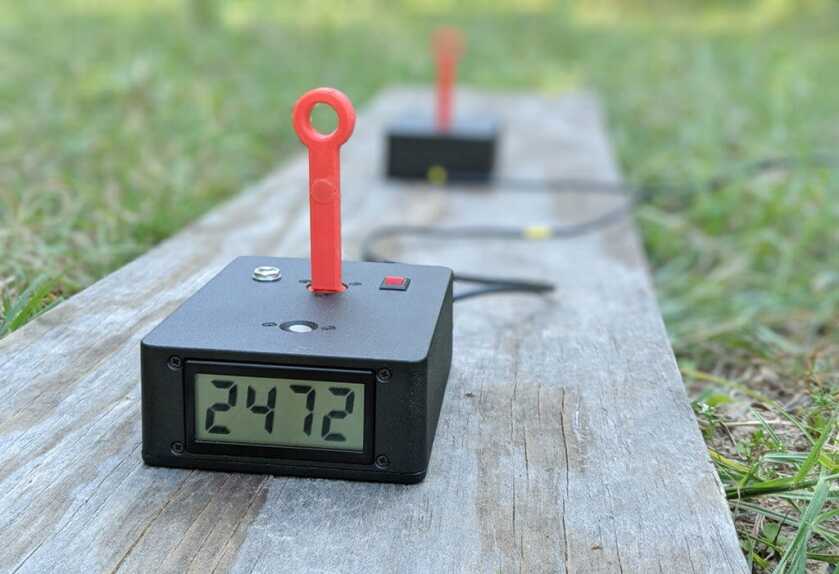
A good chronograph is an essential piece of equipment for any serious long-range shooter. Knowing how much a reloaded or factory cartridge deviates from the average velocity allows competitors to choose the load that will perform most consistently at extended ranges.
For example, small velocity deviations won’t affect the accuracy of a 308 WIN round at 100 or even 200 yards, but at 900+ yards a 20 or 30 foot-per-second (fps) difference can make or break a shot. A 168g .30-caliber projectile will drop about 337 inches at 900 yards traveling at 2610 fps at the muzzle. But if the velocity drops down to 2580 fps, that same projectile will drop an additional 10 inches at 900 yards.
Identifying which load or factory cartridge maintains the most consistent velocity is a key piece of information, and a reliable chronograph is the only way you’re going to get that info.
If you’ve been suspicious that the $50 Chrono you bought on Amazon isn’t throwing the right numbers, the Two-Box Chrono from Autotrickler might be just what you’ve been looking for.
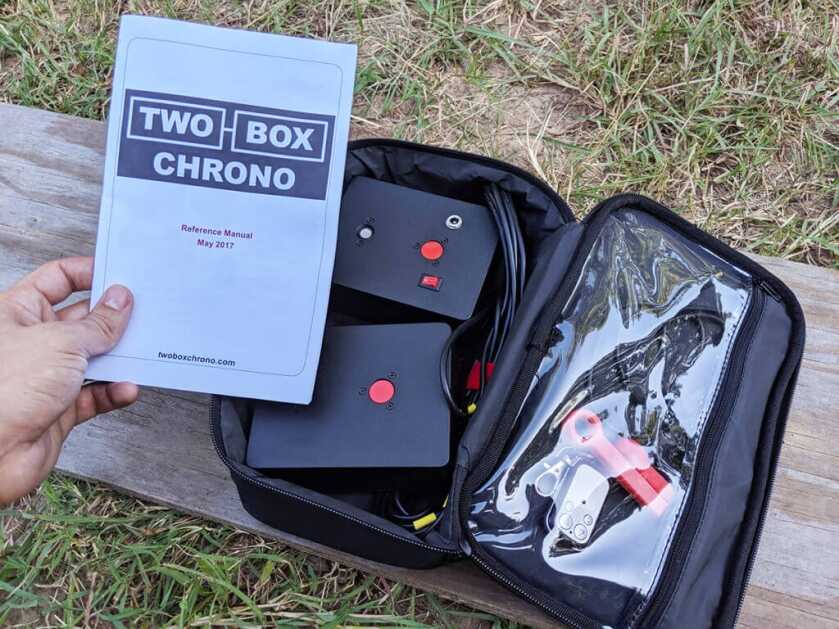
Why Is It Better?
The Two-Box Chrono was developed by Canadian long-range competitive shooter Adam MacDonald. MacDonald jumped into competitive shooting about five years ago after a career in software and electronics development and won the Canadian F-class championship in 2018.
The Two-Box Chrono (along with the Autotrickler and Shot Marker – Read GunsAmerica Review of AutoTrickler AutoThrower System HERE) is a key part of MacDonald’s scientific, evidence-based load development strategy. While other chronographs have an inherent random error of +/- 6-10 fps, MacDonald guarantees the Two-Box Chrono will maintain a repeatability error of only 0.5 fps SD or 0.02%.
The science behind the device is relatively simple. The Two-Box Chrono uses acoustic rather than optical sensors, which can record when the supersonic sound wave hits each box down to the microsecond. The sound wave is extremely strong and precise, so when the boxes are placed 15 feet apart, MacDonald can guarantee a margin of error of less than 1 fps.
“There’s literally no way the sensor itself can be ‘wrong,’” MacDonald told me via email. “The shockwave hits the sensor like a brick wall, it records the time exactly, and that’s it.”
Other chronographs, by contrast, have more uncertainty in the measurement which produces a random error in the result.
“Optical sensors have to trigger from the shadow of the bullet which may not be clearly identifiable,” MacDonald continued. “Doppler radar has to average many measurements and do a lot of math, and there is a margin of error. The acoustic approach is much more black and white.”
Setup
Setting up the Two-Box Chrono is relatively simple. Users place the first box 6-12 feet in front of the muzzle and the second box 2, 6, 10, or 15 feet beyond the first. The cable comes with yellow markers to ensure the boxes are spaced at the correct distance.
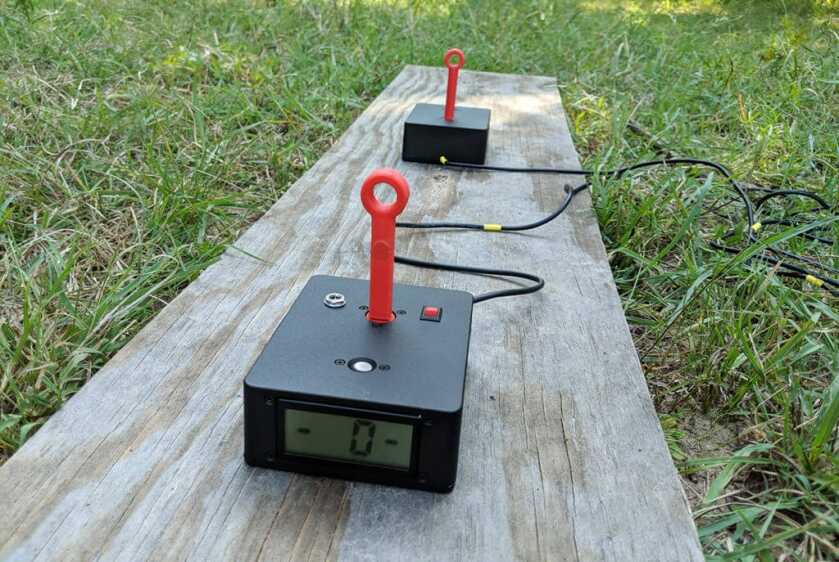
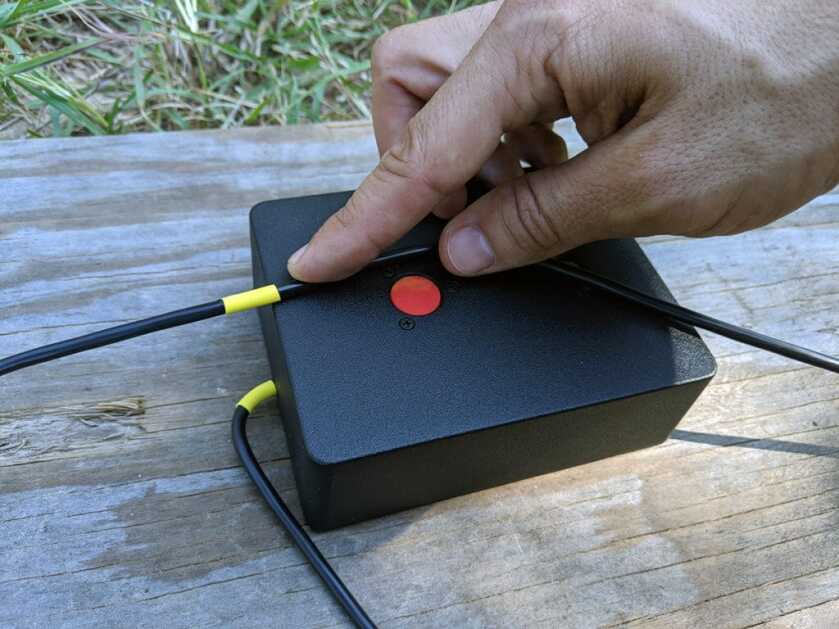
Both boxes must be within five feet below the bore line. If you’re shooting prone, this isn’t a problem. I found it helpful to use a board underneath one or both boxes to help with alignment (more on that below). If you’re shooting from a table, both boxes include tapped holes for mounting to tripods or bolting to another kind of raised surface. MacDonald cautions that whatever mounting system is used must be rock solid to keep the boxes from moving during shooting. If the boxes are screwed into tripods, he recommends hanging weights underneath to be sure they won’t move.
Once the boxes are placed securely, they must be aligned so they are parallel with the bullet path. The package comes with two magnetic peephole sights which should be aimed below the target an equal distance to the rifle’s height above the boxes. In other words, if your rifle will shoot three feet above the boxes, you should aim the boxes three feet below the target.
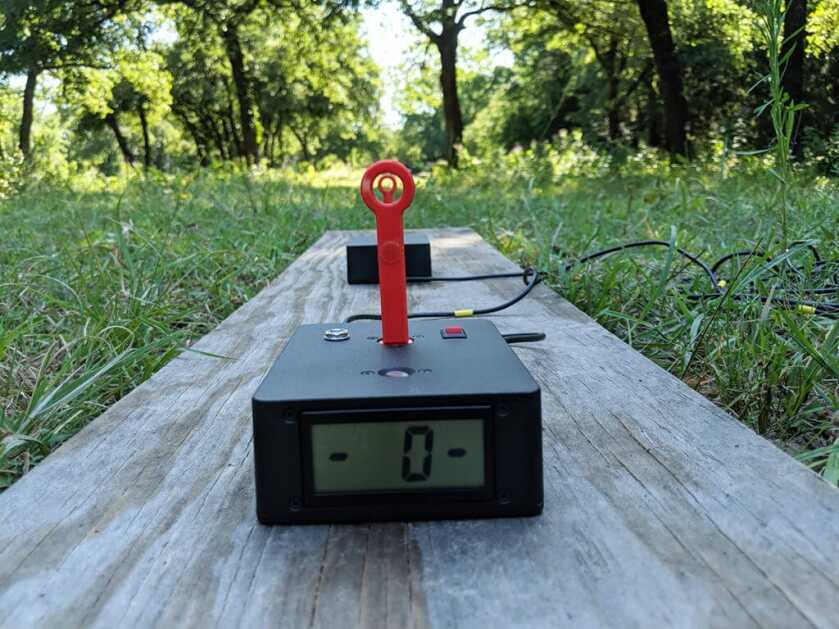
The chronograph will still work if the boxes aren’t aligned, but all measurements will be either slightly below or above the true velocity. This isn’t a problem if you’re measuring which load produces the lowest standard deviation, but if you’re looking for actual velocity, you’ll want to align the boxes.
Finally, turn the first box “On” and choose the correct distance from the menu (2, 6, 10, or 15 feet; be sure to press the “O” twice to confirm). The lithium-ion battery lasts for 60 hours and charges in three hours. MacDonald mentioned that if you ever arrive at the range and the boxes are dead, plugging them into your car’s USB port for about 15 minutes should provide enough juice for that day at the range.
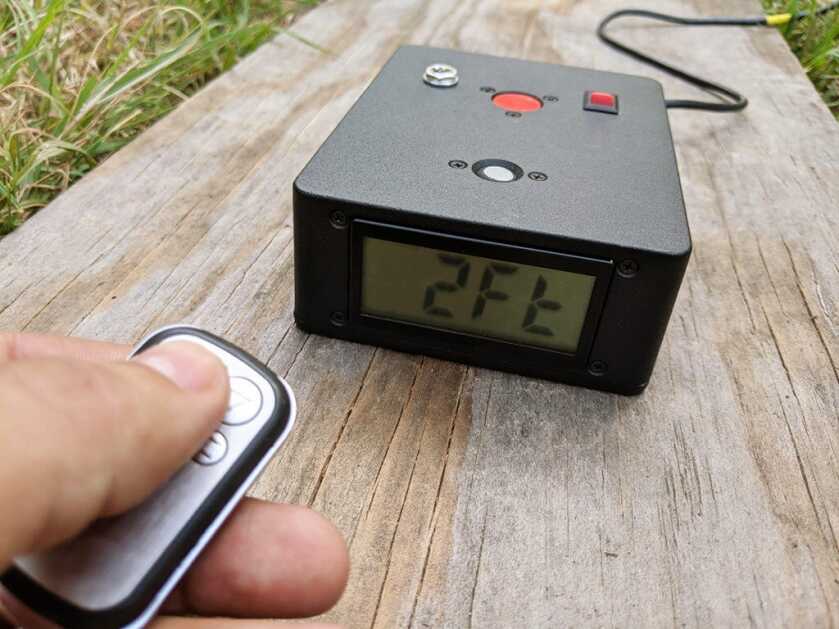

Uses, Advantages, Disadvantages
I found the Two-Box Chrono to be relatively easy to set up and use. From the prone position, I simply used a long board to steady the boxes and stapled my paper targets about two feet from the ground. This setup ensured that the boxes were parallel with the path of the bullet at 100 yards, and the results appeared to be accurate even with the boxes only two feet apart.
Setting up at a public range was somewhat more difficult. It takes a minute to align the boxes and carrying two tripods was a hassle. Range goers are among the nicest folks I’ve met, but I felt bad making everyone stop shooting so I could measure and align my chronograph.
Shooting at a public range also made tracking my shots more difficult. The boxes are extremely sensitive, so they picked up my shots along with everyone else’s. This isn’t a deal-breaker, since everyone else’s shots registered wildly different velocities than mine, and it wasn’t difficult to differentiate my shots from theirs. Still, when I reviewed the data, I had to churn through everyone else’s shots to find my own.
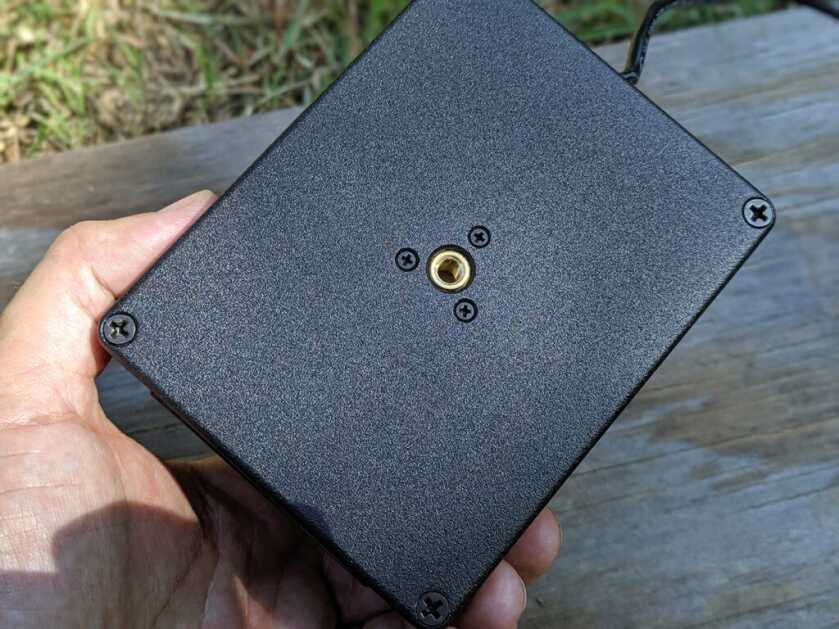
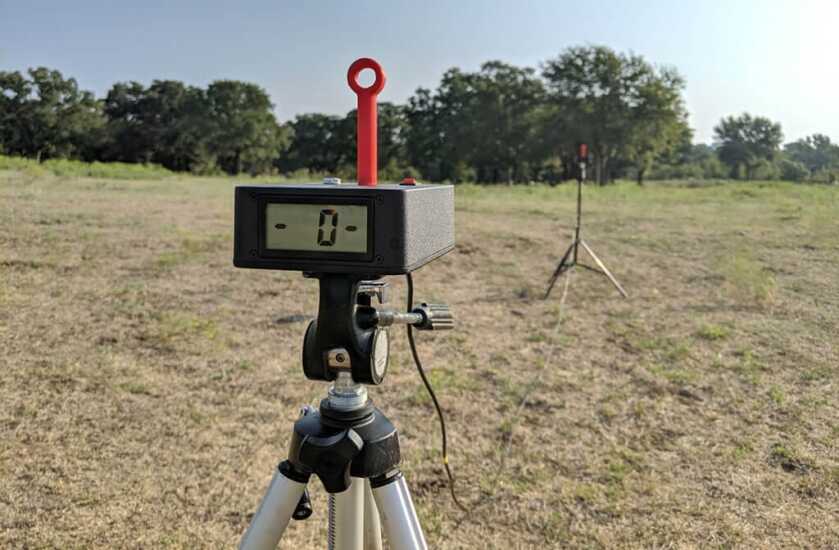
Users should also be aware that the Two-Box Chrono only registers shots traveling faster than 1250 fps. Since it uses the supersonic sound wave to track velocity, if your round isn’t travelling faster than the speed of sound, it won’t show up. This isn’t a problem for long-distance rifle shooters, but if you’re looking for a chronograph to measure pistol rounds, .22lr rounds, or subsonic 300 Blackout rounds, you’ll want to look elsewhere.
I don’t fault the Two-Box Chrono for any of these apparent disadvantages: MacDonald designed the device for developing loads for long-distance shooting. For that application, you won’t find a more precise Chrono for $250. Especially if you have access to a private range and can perfect your setup procedure, the Two-Box Chrono will deliver near-perfect velocity readings every time and ensure that you can find the perfect load for your next match.

I’d like to try it. I have a MagnetoSpeed, but it pretty useless with my muzzle break, or supressor. Mag needs to come up with better way to mount to the barrel.
In response to Thomas B.,
This instrument, as described, consists of two microphones placed within 5 feet of the bullet flight path and separated by up to 15 feet. While it is true that the speed of sound changes with air density, the effect is negligible with this unit unless you can establish an atmospheric pressure gradient over a 15 foot distance. It would change the arrival time of the shock wavefront at the microphone.
The shockfront arrival time at each microphone would be 4.50 msec at 750 mph sound velocity or 4.48 msec at 761 mph. Since both microphones are (when correctly placed) equidistant to the flight path of the bullet, these numbers don’t alter the measurement – over the microphone separation distance and assuming no pressure gradient. The setup error that would introduce significant error is if one were to place the microphones at different distances from the flight path of the bullet. A 1 foot setup distance error would result in a shorter acoustic path of ~897 microseconds with resultant velocity error of ~ 2.7 fps.
Makes sense to me…
The author, Jordan Michaels… States that, why are we getting bad numbers on the $50 Chronograph we purchased at Amazon.
1). There are no $50 chronographs at Amazon.
2). This Two-Box chronograph gives you the same accuracy as the Caldwell if they are placed within two feet of each other. Otherwise they have to be placed fifteen feet apart and another ten to fifteen feet away from the shooter. Then you need an alignment strategy… just to make sure you don’t shoot your two-box chronograph now that it has been placed about fifty feet away from you.
3). Yes, there are other chronographs just as accurate with 1000% less tinkering.
4). Yes, you can purchase a different chronograph for less money with the same results.
5). I’m just saying.
6). Still an interesting unit. The distance to set up is however a down fall.
Whether this unit uses supersonic data or not, an acoustical unit has to be influenced by temperature, altitude, and humidity which radar units do not. For example, the speed of sound on a “standard” day in south Florida at sea level would be about 1100 fps. This can change substantially if a weather front moves through dropping pressures and temps. Even the tide influences ambient air pressures along ocean fronts for a 3,000 fps round.
Now, let’s say we move the shooter from sea level to somewhere inland at a 1,000 above sea level. This changes the speed of sound from 761 to 758mph, not a big deal. But, if you move to Denver, it drops to 748mph, a moderate influence on data.
Altitude changes may seem minor but temps can create big swings in data. If you are resting at 1000 ft altitude in central Arizona, in the day you will have 791 fps on a 100F day. By evening temps can easily drop to 60F which drives down the speed of sound to 762 fps. Since this unit derives data from simple speed differentials, temp swings will shift data by 3.6%. Humidity changes influence the data even more.
In summary, I believe the concept is very good …but… good at RELATIVE data collection taken over minutes on the same day. Maybe I need to dig deeper into this unit but the “absolute” readings it shows are suspect to a lot of error over time. I would trust a radar solution more with varying climates and days but relative shot data on this unit should be quite good.
https://www.grc.nasa.gov/www/k-12/airplane/sound.html
Unless the speed of sound changes significantly between the two boxes (not likely), there isn’t an issue. As the shockwave propagates away from the bullet, it won’t matter how long it takes to reach the sensors. By aligning them parallel with the bullet’s path, whether the shockwave takes 0.006 or 0.007 seconds to reach the sensors is irrelevant because that offset is the same for both. (Two notes: one, the bullet’s path isn’t perfectly straight, so being parallel to it is a bit of a misnomer; two, the numbers I provided are probably not accurate because I simply made them up to illustrate the concept.)
I like the concept. Looks like setup could be a little more finicky to get true velocity. I’ll stick to my labradar for now. I don’t shoot anything over 4k fps, or fool with much smaller than 6mm so the labradar does just fine for me. If I did load for anything in that realm, I would definitely look more into this. I also like not having to set up anything down range. But his autotrickler is great.
More complicated setup than my LabRadar unit….for a couple hundred bucks more, I\’ll stick with the Doppler Radar that goes on the bench and doesn\’t require my shutting down the rest of the range while I position it
An interesting design, however, the Magnetospeed is much better at half the price. It attaches to the end of the rifle barrel, so one can get chrono data at the same time as zeroing the rifle, and without worrying about shooting the instrument. (After fighting my Caldwell chrono, I wanted to shoot it…). Installation and set up is all on the bench behind the firing line. No no need to disturb the rest of the range.
So, you said I would not find a more precise chrono for $250, but how much is THIS chrono?
This one is $250.
The car’s USB port? Do they actually make cars with USB ports? haha.
A couple weeks ago, checking velocity of a 45-70 load, an over powder wad hit the screen of my Chrony, smashed it. Now Looking for a new chronograph.
The data above is not very helpful. It indicates usual chronograph so have inherent precision of 6-10 fps, then states a reapatability error of 0.5 SD for this unit. Not an apple to Apple comparison.
What standard is used to measure this precision?
I am also interested in an accurate chronograph, how accurate is this unit and what is the standard ?
Thanks,
martianone
That’s a good question. According to the Autotrickler website, the Two-Box Chrono will get you within 1-2fps.